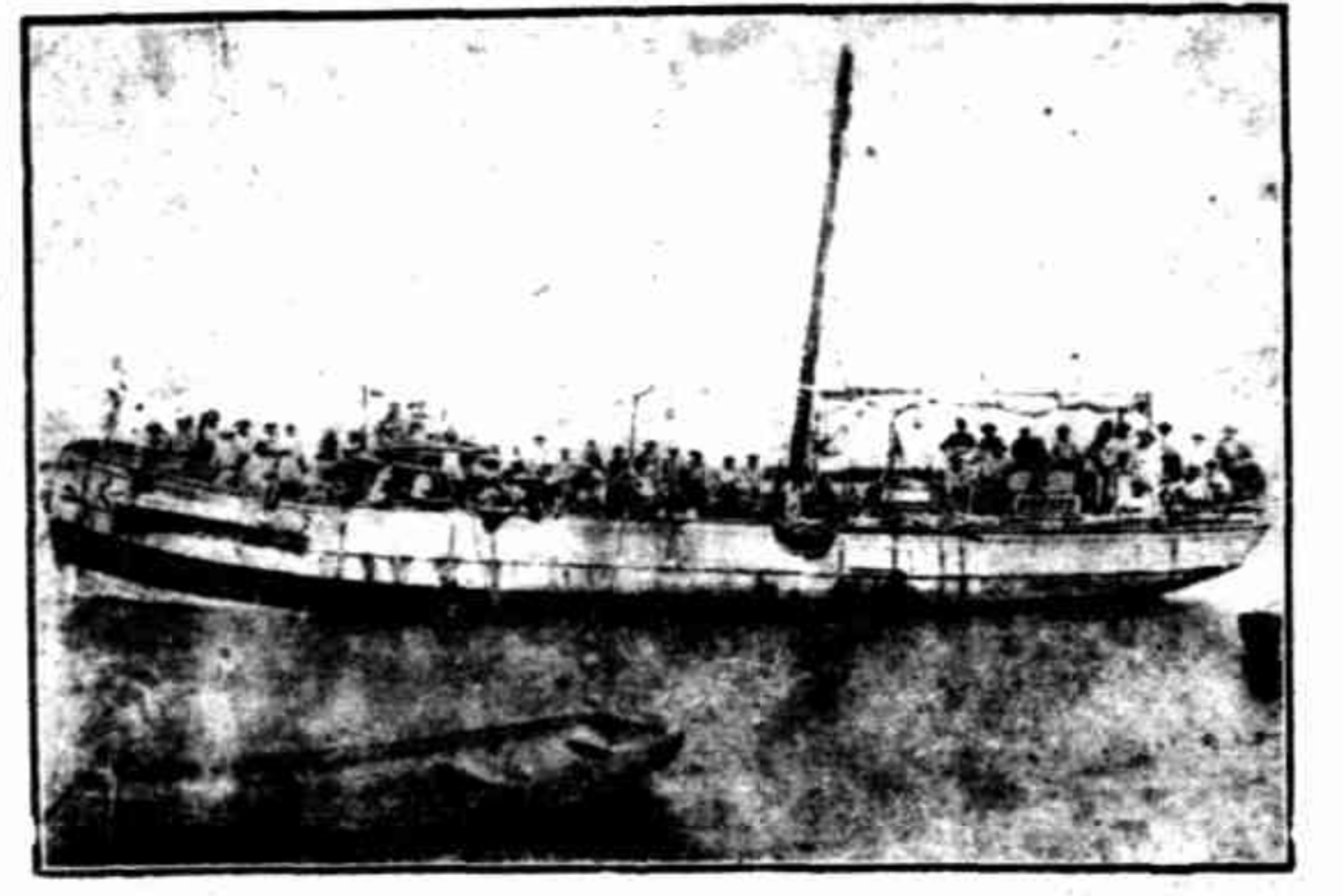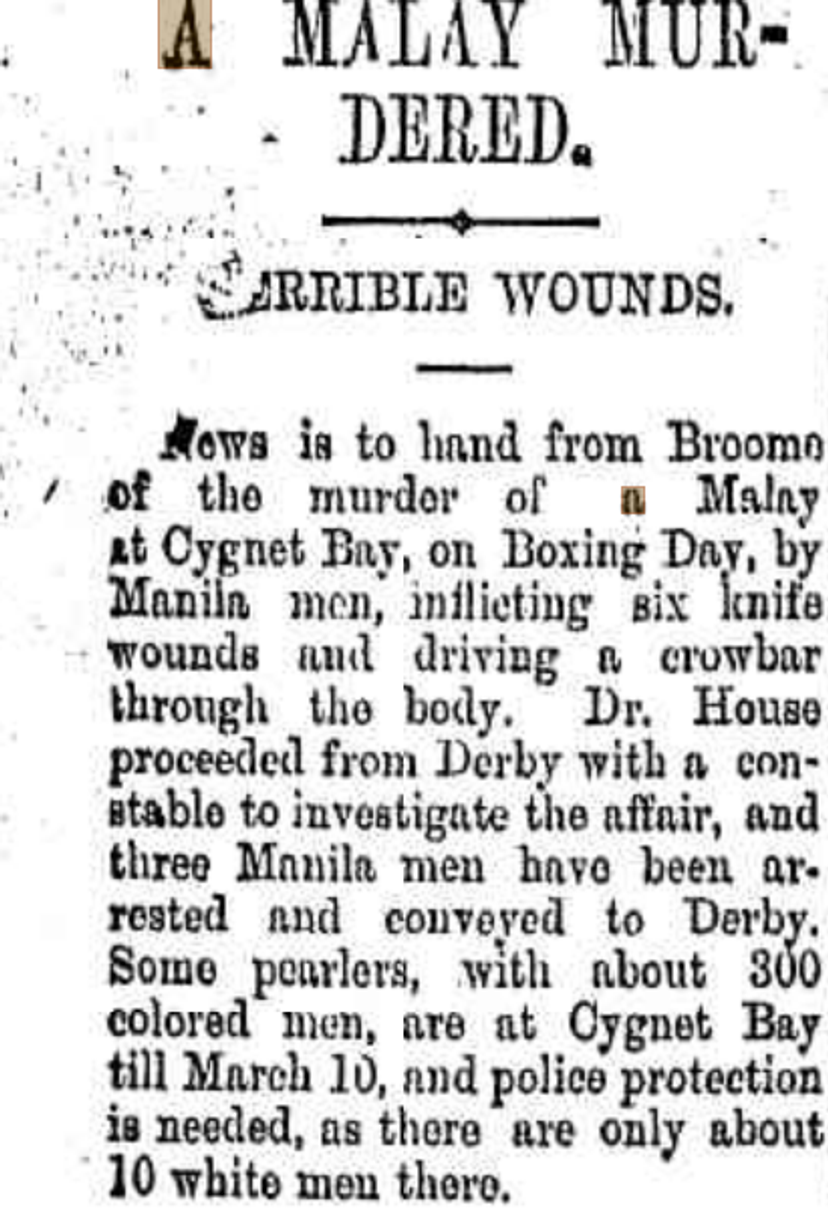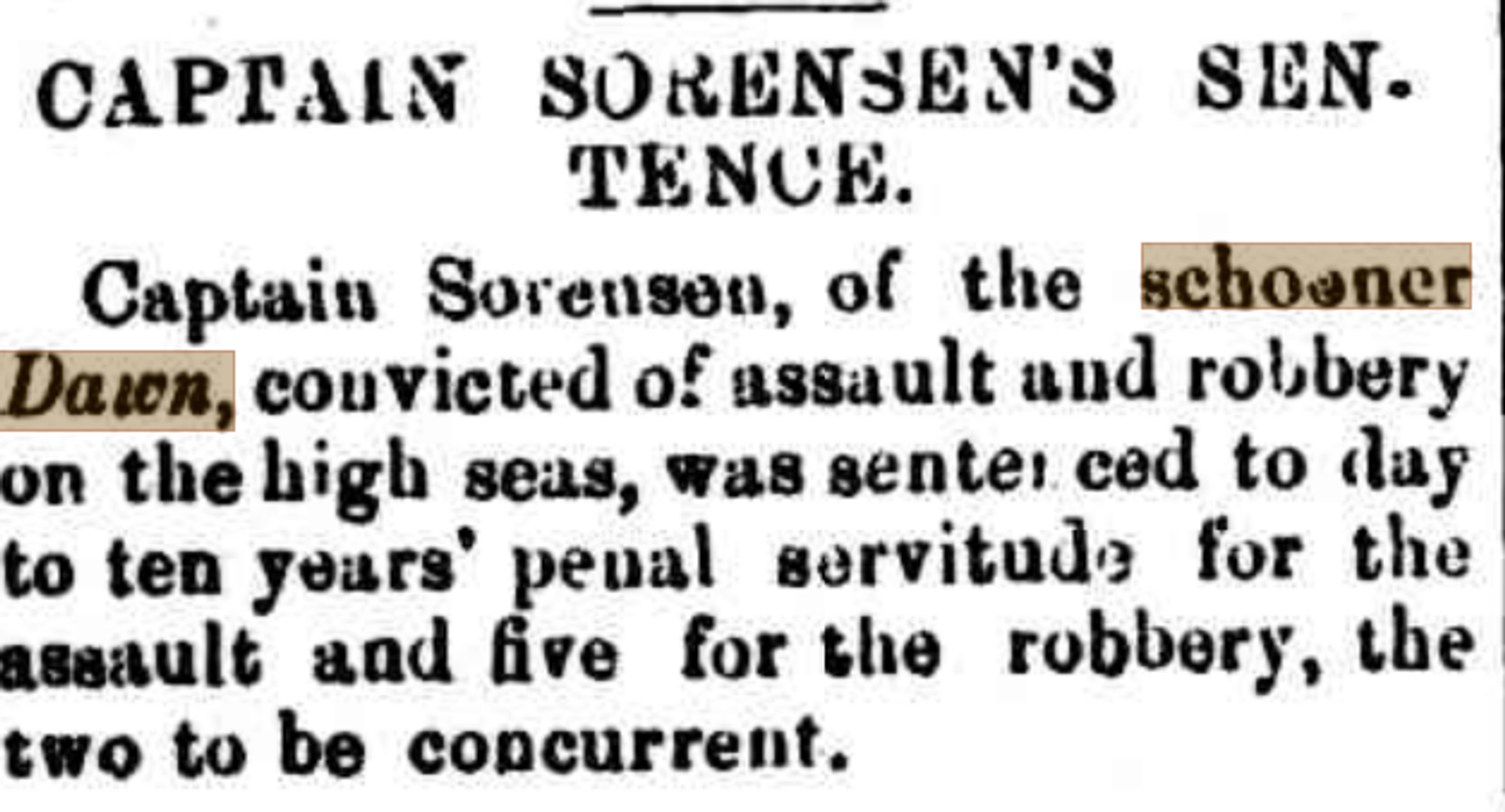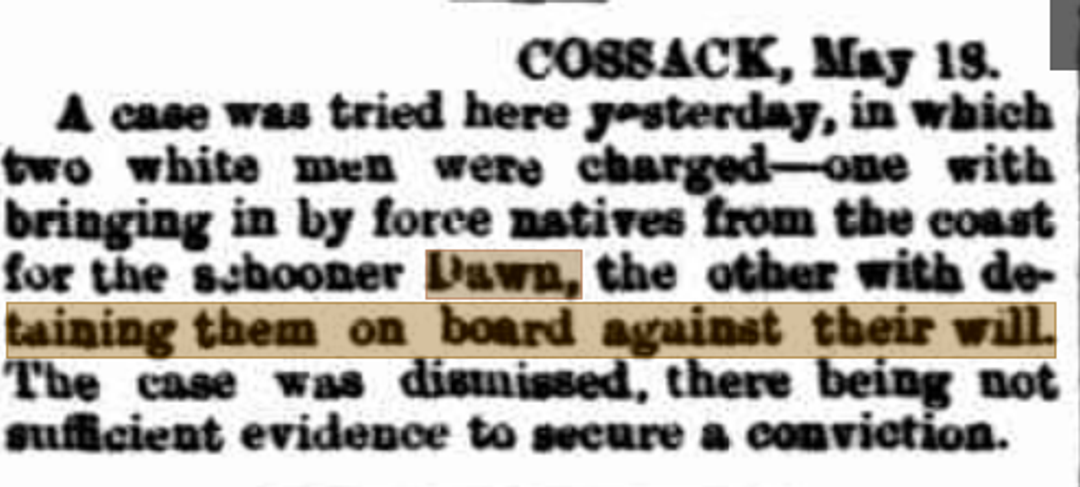Karium
Vessel Name: Dawn
Karium
Murdered; body buried at Cygnet Bay
25 December 1894

The Dawn



Karium was a Siamese diver working aboard the Dawn, a 63-ton wooden schooner and the mother boat for up to 12 luggers (10 – 15 ton). Dawn was built in England and registered officially in Fremantle as number 61094. She was 72 feet long [21 metres], 17 feet across the beam [5.2metres] and had a draught of 8.5 feet [2.6 metres]. She had three to four men for each lugger, plus her own crew: a total of 60 men. Dawn was owned by William Pearse and Mr John McRae and known for the large amounts of pearl shell she took, often more than the other boats in the fleet. John McRae was known for the number and quality of valuable pearls his crew found.
On 25 December 1894 the crews of Dawn and Mist were anchored 400 yards [366 metres] from shore in Cygnet Bay. The crews were at the Dayspring camp making repairs and enjoying a rare break from work. Most of the crew were Siamese and Malay. Both crews were drinking and an altercation between the two races broke out.
The argument turned into a fracas of 30 or 40 men. Weapons were drawn, and the fight became serious. Karium brandished a tomahawk and challenged the Malays to fight him. Initially no one accepted the challenge, but when he narrowly missed striking a Malay some of the men tried to take the tomahawk from him. A Malay called Ngur [also known as Tiago] wielding an iron bar accepted Karium's challenge.
Details varied on the sequence of blows Ngur used to strike Karium. Most witnesses agreed he fell after the second blow to his face. The first and second strikes knocked him to his knees. He dropped the tomahawk in the water. A third blow to the back of Karium’s neck caused him to fall face down in the shallow water. Apparently Ngur prepared to strike Karium again, however he missed, dropped the iron bar and walked away.
Mr Duthie, shipwright at the Dayspring camp, saw what was happening, and attempted to shout to Ngur to stop him from his assaulting Karium. He tried to call out for the Siamese to lift Karium out of the water, but he could not be heard in the noise of the riot. Mr Duthie raced to the beach with medical supplies from the camp. Karium was insensible but alive. Mr Duthie applied Friar’s Balsam and bandage and took Karium to the Dawn.
Two hours later, Mr Duthie was informed Karium had died on board the Dawn. At 1pm Dawn’s mate rowed over to Mist where Mr S.J. Viddler, Customs House Officer and Special Constable was aboard. The mate told him that one of his crew members died aboard from injuries sustained ashore. Mr Viddler went across to the Dawn and saw a body lying across the top of the hatch with deep wounds to his head and face. A three-inch wound on the back of the neck was sufficient to cause death. There was a deep one and a half inch cut above the right eye, and a one inch cut under the eye exposing the cheek bone.
Mr Viddler went ashore and informed the authorities. Ngur was soon arrested on a charge of murder and transported to Roebourne jail. The weapons used in the incident were picked up by other men involved in the riot. They were soon handed to Mr Duthie who kept them at the camp as evidence until the trial. The tomahawk was taken from a Malay called Assam and another man handed in the iron bar. Karium was buried at Cygnet Beach that evening.
The trial started at a special session of the Supreme Court in Roebourne on 4 April 1895, and was adjourned to 11 April to allow depositions and witness statements to be prepared. The charge was reduced to manslaughter by the Attorney General after he had read the depositions prepared for the trial. The case was heard before Commissioner Roe and a jury of 12 men Inspector Lawrence represented the crown. Ngur was not represented.
Witnesses included Mr Duthie, Mr Viddler and other men from the beach. A Malay diver called Sallie, employed by Robison & Norman on Mist he provided evidence of the blows Ngur inflicted on Karium. Another Malay, Jahlil from Mist confirmed Karium’s challenge while armed with the tomahawk. A third Malay, Crisco Neibis, attested to the use of the weapons by both Ngur and Karium in the fight and stated Karium was alive when he put him in the dinghy and rowed him to the Dawn.
From the Dawn, a Siamese called Ouisim said he thought Assam the Malay diver hit Karium. A Manilaman, Maxwell Flatwick stated he saw Karium with the tomahawk, and Ngur striking him.
The jury retired at 3.30pm and returned at 3.45pm with a verdict of guilty. Given the circumstances surrounding the case, Ngur was sentenced to one year imprisonment.
The Dawn had many incidents prior to the manslaughter of Karium. There was another murder aboard in 1888. [See the story of Captain Claudius Ker].
In February 1873, Dawn was one of several boats in Fremantle when a strong squall caused the small fleet to part anchors and cables and drive ashore. The damage bill for insurance was such that it prompted an inquiry presided over by L. Worsley Clifton, Collector of Customs. Captain Croke of the Royal Navy assessed damage, and J. de M. Absolon assisted. Master James Simpson of the Dawn was called as a witness. Dawn smashed against the watering jetty damaging the vessel and a portion of the jetty. She was hauled off the beach three days later and repaired for return to the pearling grounds.
In August 1873, the Fremantle court found a crew member, Wrightson, of the Dawn guilty of failing to pay his board at a boarding house belonging to Mr Vogelstrom. The court determined Wrightson pay Mr Vogelstrom the sum of £2 12s 3d. Wages were not distributed on a regular basis, and relied on the master ensuring the crew was paid.
In 1886 her master, Captain Sorensen was convicted of assault and robbery “on the high sea”. He committed the offences against his crew. He was found guilty and was sentenced to 10 years of penal servitude for the assault, and two concurrent years for the robbery.
In 1887, Aenus MacPherson, master, and crew member Mugford were charged with kidnapping and putting restraints on natives. The men had forced Aboriginals aboard and kept them against their will [Blackbirding]. There was a trial on 17 May at Cossack. The charge was dismissed for want of evidence. The incident put the boat’s owners on notice to use legal contracts. Dawn travelled to Koepang [Timor] and Malaya to find contract crew.
In 1887 Dawn was thought to be lost in a cyclone in Exmouth Gulf. She had not arrived in Fremantle with her full load of pearl shell, some wreckage was found at Banningarra Creek and there was word Dawn had been seen on her beam ends and had foundered. Master Owen had left Banningarra the day before the cyclone on 7 January. She put into Cossack a few days later, minus her masts and rigging. She had sustained serious damage, but no crew were lost, and she was repaired and returned to the Gulf.
In April 1892, Dawn was enlisted to raise the Alice, a lugger which had sunk at Mermaid Strait. A cyclone struck the area and Dawn parted from her anchors and the crew abandoned her. They returned after the cyclone had blown out and found her 10 miles (16 kms) from where they had left her. On 22 October 1892 the “Western Mail” published a single line to say that Dawn’s Chinese cook had been washed overboard and drowned at the Roebourne pearling grounds.
In January 1894 Dawn narrowly escaped another cyclone at Roebourne. She had to cut her masts away to avoid capsizing in the gale winds. Many boats sank or were washed into the mangroves but Dawn able to ride out the cyclone, damaged, but repairable. She safely survived a cyclone at Exmouth Gulf in February 1894 while much of the fleet sustained damage and loss of life.
In February 1894, Captain Robert Barter purchased Pearse’s interest of Pearse & McRae, thus becoming owner of the Dawn. He was joined by A.G. Bayne; 1st Officer of the Saladin who wanted to join the pearling venture. Captain Barter set out for the pearling grounds in Roebourne and Cossack. Mr F. Pearse retired to Fremantle after 29 years of pearling. Mr John McRae had died, and F. McRae represented the McRae family in the business.
After a long and eventful life Dawn was wrecked and sank off Maud’s Landing in 1902, under master William Dundee. She was on her way to Fremantle for repairs. The crew survived the wrecking. Master Dundee was sued in court for recompense of fares paid by three passengers. He was ordered to repay the fares plus court costs.
